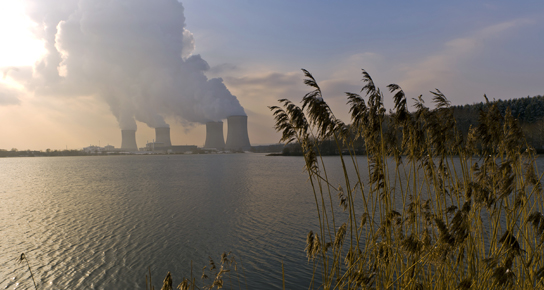Search
Recent comments
- meanwhile.....
2 hours 34 min ago - young losers....
3 hours 9 min ago - bulgarian slow train....
3 hours 14 min ago - a six-minute read...
6 hours 12 min ago - inexpensive....
8 hours 4 min ago - obviously....
8 hours 10 min ago - macronleon de gaulle.....
10 hours 29 min ago - nazis in washington.....
10 hours 38 min ago - blinkenings.....
18 hours 12 min ago - georgia's NGOs
19 hours 12 min ago
Democracy Links
Member's Off-site Blogs
climate change and the nuclear power stations conundrum..

nuclear power station (le Monde)
In the United States and Europe, at present 91% and 78% (ref. 1) of the total electricity is produced by thermoelectric (nuclear and fossil-fuelled) power plants, which directly depend on the availability and temperature of water resources for cooling. During recent warm, dry summers several thermoelectric power plants in Europe and the southeastern United States were forced to reduce production owing to cooling-water scarcity2, 3, 4.
Here we show that thermoelectric power in Europe and the United States is vulnerable to climate change owing to the combined impacts of lower summer river flows and higher river water temperatures. Using a physically based hydrological and water temperature modelling framework in combination with an electricity production model, we show a summer average decrease in capacity of power plants of 6.3–19% in Europe and 4.4–16% in the United States depending on cooling system type and climate scenario for 2031–2060. In addition, probabilities of extreme (>90%) reductions in thermoelectric power production will on average increase by a factor of three. Considering the increase in future electricity demand, there is a strong need for improved climate adaptation strategies in the thermoelectric power sector to assure future energy security.
http://www.nature.com/nclimate/journal/vaop/ncurrent/full/nclimate1546.html
- By Gus Leonisky at 8 Jun 2012 - 7:38pm
- Gus Leonisky's blog
- Login or register to post comments
historical period 1971–2000...
The performance of the modelling framework was tested for the historical period 1971–2000. Observed daily series of river flow and water temperature for 1,267 river discharge stations and 240 water temperature monitoring stations were used to evaluate the quality of the simulations for Europe and North America (Supplementary Section S2 and Figs S2–S5).
http://www.nature.com/nclimate/journal/vaop/ncurrent/full/nclimate1546.html